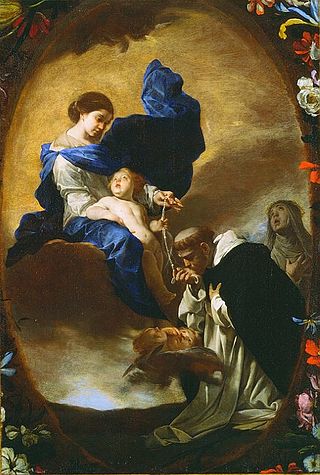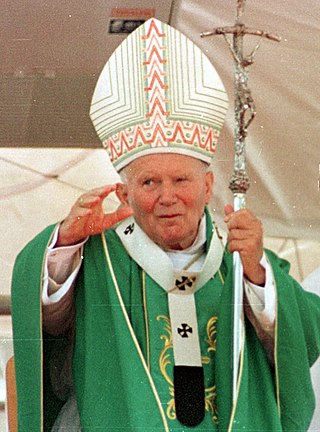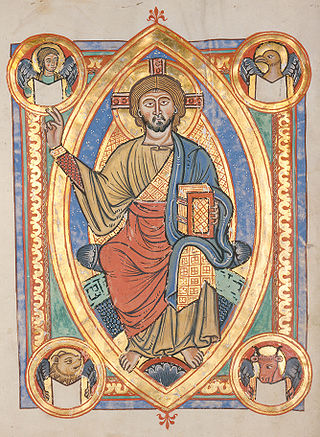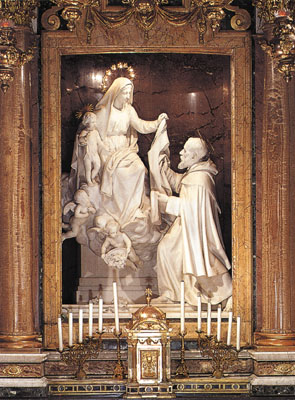
The Rosary, also known as the Dominican Rosary, refers to a set of prayers used primarily in the Catholic Church, and to the physical string of knots or beads used to count the component prayers. When referring to the prayer, the word is usually capitalized ; when referring to the prayer beads as an object, it is written with a lower-case initial letter.

The teachings of Pope John Paul II are contained in a number of documents. It has been said that these teachings will have a long-lasting influence on the Church.
Catholic spirituality includes the various ways in which Catholics live out their Baptismal promise through prayer and action. The primary prayer of all Catholics is the Eucharistic liturgy in which they celebrate and share their faith together, in accord with Jesus' instruction: "Do this in memory of me." The Catholic bishops at the Second Vatican Council decreed that "devotions should be so drawn up that they harmonize with the liturgical seasons, accord with the sacred liturgy, are in some fashion derived from it, and lead the people to it, since, in fact, the liturgy by its very nature far surpasses any of them." In accord with this, many additional forms of prayer have developed over the centuries as means of animating one's personal Christian life, at times in gatherings with others. Each of the religious orders and congregations of the Catholic church, as well as lay groupings, has specifics to its own spirituality – its way of approaching God in prayer to foster its way of living out the Gospel.

Totus tuus is a Latin greeting which was routinely used to sign off letters written in Latin, meaning "all yours", often abbreviated as "t.t.". In recent history Totus tuus was used by Pope John Paul II as his personal motto to express his personal Consecration to Mary based on the spiritual approach of Louis de Montfort and the Mariology in his works. The pontiff explained the meaning further in his 1994 book Crossing the Threshold of Hope where he defines it as not only an expression of piety but also of devotion that is deeply rooted in the Mystery of the Blessed Trinity.

The Secret of the Rosary is a book about the Holy Rosary written by Louis de Montfort, a French priest and Catholic saint who died in 1716. The English translation of the book bears the Imprimatur of Archbishop Thomas E. Molloy of the Roman Catholic Diocese of Brooklyn. It is said to be the earliest extant book describing the modern way in which the Rosary is prayed.

True Devotion to Mary is a 1712 book by Saint Louis de Montfort on the Roman Catholic theme of devotion to the Blessed Virgin Mary. The original manuscript was discovered in 1842. The book was first published in 1843, more than a century following de Montfort's death in 1716.

Secret of Mary is a book by Saint Louis de Montfort on the Roman Catholic theme of devotion to the Blessed Virgin Mary.

Five methods of praying the rosary are presented within the works of Louis de Montfort, a French Roman Catholic priest and writer of the early 18th century. Montfort was an early proponent of Mariology, and much of his work is devoted to the subjects of the Blessed Virgin Mary and the rosary. While the rosary contains a fixed set of prayers recited with the use of beads, Montfort proposed a number of methods to pray the rosary with more thorough devotion. Two of the methods are described in his book The Secret of the Rosary, in the fiftieth rose (chapter):
"In order to facilitate the exercise of the holy Rosary, here are several methods to recite it holily, with the meditation of the joyful, sorrowful and glorious mysteries of Jesus and Mary. You stop at that which is most to your liking: you can form yourself another particular method, as several saintly persons have done."

Redemptoris Mater is an encyclical by Pope John Paul II delivered on March 25, 1987 in Saint Peter's Basilica in Rome. Subtitled On the Blessed Virgin Mary in the life of the Pilgrim Church, the text addresses a number of topics in Mariology.

Throughout history, Catholic Mariology has been influenced by a number of saints who have attested to the central role of Mary in God's plan of salvation. The analysis of Early Church Fathers continues to be reflected in modern encyclicals. Irenaeus vigorously defended the title of "Theotokos" or Mother of God. The views of Anthony of Padua, Robert Bellarmine and others supported the doctrine of the Immaculate Conception of the Virgin Mary, which was declared a dogma in 1850.

The Mariology of the popes is the theological study of the influence that the popes have had on the development, formulation and transformation of the Roman Catholic Church's doctrines and devotions relating to the Blessed Virgin Mary.

Catholic Marian movements and societies have developed from the veneration of the Blessed Virgin Mary by members of the Catholic Church. These societies form part of the fabric of Mariology in the Catholic Church. Popular membership in Marian organizations grew significantly in the 20th century, as apparitions such as Our Lady of Fátima gave rise to societies with millions of members, and today many Marian societies exist around the world. This article reviews the major Marian movements and organizations.

A number of prayers to Jesus Christ exist within the Roman Catholic tradition. These prayers have diverse origins and forms. Some were attributed to visions of saints, others were handed down by tradition.

Saint Louis de Montfort's Prayer to Jesus is a reflection of his philosophy of "total consecration to Jesus Christ through Mary", a theme that centuries later influenced the development of Roman Catholic Mariology.

The exact origins of both the rosary and scapular are subject to debate among scholars. Pious tradition maintains that both the rosary and the brown Scapular of Our Lady of Mount Carmel were given by the Virgin Mary to Dominic and Simon Stock respectively during the 13th century. Historical records document their growth during the 16th and 17th centuries in Europe. By the early 20th century, they had gained such a strong following among Catholics worldwide that Josef Hilgers, writing in the Catholic Encyclopedia of 1914, stated: "Like the Rosary, the Brown scapular has become the badge of the devout Catholic."
The rosary is one of the most notable features of popular Catholic spirituality. According to Pope John Paul II, rosary devotions are "among the finest and most praiseworthy traditions of Christian contemplation." From its origins in the twelfth century the rosary has been seen as a meditation on the life of Christ, and it is as such that many popes have approved of and encouraged its recitation.
Preparation for Total Consecration according to Saint Louis Marie de Montfort was inspired by Louis de Montfort and published in 2001. Saint Louis dedicated his life to following and praying to the Virgin Mary. His devotion to Mary was even considered "the best and most acceptable form of devotion to Our Lady" by Pope Pius IX. Four of his performed miracles were examined by the Sacred Congregation. Saint Louis de Montfort was canonized by Pope Pius XII on July 20, 1947, over two hundred years after his death. The process took a very long time due to his lack of followers and the unfortunate era in which he died. His two biographies, one by Grandet and the other Father de Clorivière, both dated in the 1700s, which was a time of "immense social and religious upheaval."

The consecration and entrustment to the Virgin Mary is a personal or collective act of Marian devotion among Catholics, with the Latin terms oblatio, servitus, commendatio and dedicatio being used in this context. Consecration is an act by which a person is dedicated to a sacred service, or an act which separates an object, location or region from a common and profane mode to one for sacred use. The Congregation for Divine Worship and the Discipline of the Sacraments clarifies that in this context, "It should be recalled, however, that the term "consecration" is used here in a broad and non-technical sense: the expression is use of 'consecrating children to Our Lady', by which is intended placing children under her protection and asking her maternal blessing for them".

Louis-Marie Grignion de Montfort, TOSD was a French Catholic priest known for his preaching and his influence on Mariology. He was made a missionary apostolic by Pope Clement XI. Montfort wrote a number of books which went on to become classic Catholic titles and influenced several popes. His most notable works regarding Marian devotions are contained in Secret of the Rosary and True Devotion to Mary.

Henri-Marie Boudon was a 17th-century Roman Catholic French abbot and spiritual author.














